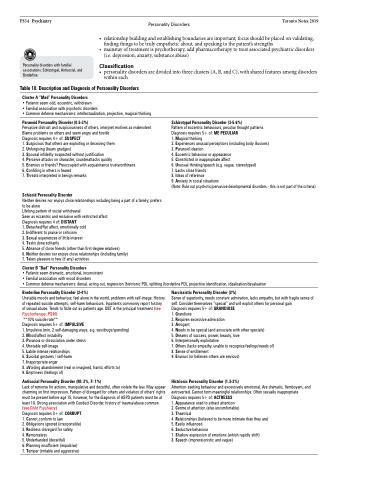Page 1198 - TNFlipTest
P. 1198
PS34 Psychiatry Personality Disorders Toronto Notes 2019
Personality disorders with familial associations: Schizotypal, Antisocial, and Borderline
• relationshipbuildingandestablishingboundariesareimportant;focusshouldbeplacedonvalidating, finding things to be truly empathetic about, and speaking to the patient’s strengths
• mainstayoftreatmentispsychotherapy,addpharmacotherapytotreatassociatedpsychiatricdisorders (i.e. depression, anxiety, substance abuse)
Classification
• personalitydisordersaredividedintothreeclusters(A,B,andC),withsharedfeaturesamongdisorders within each
Table 10. Description and Diagnosis of Personality Disorders
Cluster A “Mad” Personality Disorders
• Patients seem odd, eccentric, withdrawn
• Familial association with psychotic disorders
• Common defense mechanisms: intellectualization, projection, magical thinking
Paranoid Personality Disorder (0.5-3%)
Pervasive distrust and suspiciousness of others, interpret motives as malevolent Blame problems on others and seem angry and hostile
Diagnosis requires 4+ of: SUSPECT
1. Suspicious that others are exploiting or deceiving them
2. Unforgiving (bears grudges)
3. Spousal infidelity suspected without justification
4. Perceive attacks on character, counterattacks quickly
5. Enemies or friends? Preoccupied with acquaintance trustworthiness 6. Confiding in others is feared
7. Threats interpreted in benign remarks
Schizoid Personality Disorder
Neither desires nor enjoys close relationships including being a part of a family; prefers to be alone
Lifelong pattern of social withdrawal
Seen as eccentric and reclusive with restricted affect
Diagnosis requires 4 of: DISTANT
1. Detached/flat affect, emotionally cold
2. Indifferent to praise or criticism
3. Sexual experiences of little interest
4. Tasks done solitarily
5. Absence of close friends (other than first-degree relatives)
6. Neither desires nor enjoys close relationships (including family) 7. Takes pleasure in few (if any) activities
Cluster B “Bad” Personality Disorders
Schizotypal Personality Disorder (3-5.6%)
Pattern of eccentric behaviours, peculiar thought patterns Diagnosis requires 5+ of: ME PECULIAR
1. Magical thinking
2. Experiences unusual perceptions (including body illusions) 3. Paranoid ideation
4. Eccentric behaviour or appearance
5. Constricted or inappropriate affect
6. Unusual thinking/speech (e.g. vague, stereotyped)
7. Lacks close friends
8. Ideas of reference
9. Anxiety in social situations
(Note: Rule out psychotic/pervasive developmental disorders - this is not part of the criteria)
• Patients seem dramatic, emotional, inconsistent
• Familial association with mood disorders
• Common defense mechanisms: denial, acting out, regression (histrionic PD), splitting (borderline PD), projective identification, idealization/devaluation
Borderline Personality Disorder (2-4%)
Unstable moods and behaviour, feel alone in the world, problems with self-image. History of repeated suicide attempts, self-harm behaviours. Inpatients commonly report history of sexual abuse. Tends to fizzle out as patients age. DBT is the principal treatment (see Psychotherapy, PS40)
**10% suicide rate**
Diagnosis requires 5+ of: IMPULSIVE
1. Impulsive (min. 2 self-damaging ways, e.g. sex/drugs/spending) 2. Mood/affect instability
3. Paranoia or dissociation under stress
4. Unstable self-image
5. Labile intense relationships
6. Suicidal gestures / self-harm
7. Inappropriate anger
8. aVoiding abandonment (real or imagined, frantic efforts to)
9. Emptiness (feelings of)
Antisocial Personality Disorder (M: 3%, F: 1%)
Lack of remorse for actions, manipulative and deceitful, often violate the law. May appear charming on first impression. Pattern of disregard for others and violation of others’ rights must be present before age 15; however, for the diagnosis of ASPD patients must be at least 18. Strong association with Conduct Disorder, history of trauma/abuse common (see Child Psychiatry)
Diagnosis requires 3+ of: CORRUPT 1. Cannot conform to law
2. Obligations ignored (irresponsible) 3. Reckless disregard for safety
4. Remorseless
5. Underhanded (deceitful)
6. Planning insufficient (impulsive) 7. Temper (irritable and aggressive)
Narcissistic Personality Disorder (2%)
Sense of superiority, needs constant admiration, lacks empathy, but with fragile sense of self. Consider themselves “special” and will exploit others for personal gain
Diagnosis requires 5+ of: GRANDIOSE
1. Grandiose
2. Requires excessive admiration
3. Arrogant
4. Needs to be special (and associate with other specials)
5. Dreams of success, power, beauty, love
6. Interpersonally exploitative
7. Others (lacks empathy, unable to recognize feelings/needs of) 8. Sense of entitlement
9. Envious (or believes others are envious)
Histrionic Personality Disorder (1.3-3%)
Attention-seeking behaviour and excessively emotional. Are dramatic, flamboyant, and extroverted. Cannot form meaningful relationships. Often sexually inappropriate Diagnosis requires 5+ of: ACTRESSS
1. Appearance used to attract attention
2. Centre of attention (else uncomfortable)
3. Theatrical
4. Relationships (believed to be more intimate than they are) 5. Easily influenced
6. Seductive behaviour
7. Shallow expression of emotions (which rapidly shift)
8. Speech (impressionistic and vague)


